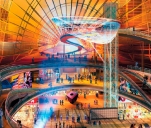Underground Highway

Swiftly developing cities come across the universal problem - how to organize the urban traffic. The mass migration entails dramatic vehicular take-up, whilst the existing urban transportation system is often likely to be unfit for the reality of a modern city. Underdevelopment of urban motorway network and prevailing traffic conditions brake on normal operation of urban organism.
Presently, the cities are characterized, in particular, by traffic jams even on mains, lowest speeds and ineffective public conveyances. Violation of road safety principles for both vehicles and pedestrians, time-consuming commutations, being late for work or studies lead to economic disbenefits and worsen living conditions. Current city zoning frequently aggravate congestion of basic thoroughfares, because territories are detached by natural and artificial barriers, dissociation of dormitory areas and just few shortest direct transfer lines connecting adjacent boroughs. Therefore the contemporary urban planning pays even more attention to arranging up-to-date transport mains and interchanges.
Background and overview
Incheon city is the 3rd biggest city in South Korea which is placed next to Seoul, capital of Korea, and has more than 2.7 millions population. The three sides of the site are surrounded by hills. It is the important traffic point of Incheon city because of the concentration of interchange of highway and five arterial streets together. Nowadays, the district feature low- and medium-profile residential and retail structures. Gyeongin highway is the first highway line in Korea which connects between Seoul and Incheon.
Since the highway passes through the central part of Incheon city, it is problem that the existing cities are divided by the highway. Furthermore today the highway has an east-south turn, which also adds issues. The Incheon International Airport, which became the main all over the country, has become the key driver of economic development of suburbs setting the coastal area to be an exclusive economic zone.
This and other important reasons have urged “straightening” of Gyeongin expressway with hiding it partially underground. Nikken Sekkei has been involved in this project through a schematic design of urban infrastructure getting the 1st prize on the competition held in March, 2008 and a schematic design of architecture on the complex urban infrastructure.
Incheon Gajeong Dong Intersection (LU 1 City)
Location: Incheon, South Korea
Site area: Approx. 96.5 ha
Central Core area: 5.7 ha
Program: offices, apartments, transport infrastructure
Client: Incheon Metropolitan City, Korea Land & Housing Corporation
Design period: 2005 (concept) – 2014 (scheduled completion)
Program: World’s 1st vertical complex city combined with underground highway, LRT and BRT
Functions: LRT and BRT , underground expressway, Central Core, cultural establishments, underground town with road network, multifunctional infrastructure
Client: Incheon Metropolitan City, Korea Land & Housing Corporation
Master plan: Seoyeong Engineering, Nikken Sekkei
Architectural Design: Nikken Sekkei, Samoo Architects & Engineers, Mooyoung Architects & Engineers
Full version you can download here
 Information provided by Nikken Sekkei
Information provided by Nikken Sekkei


